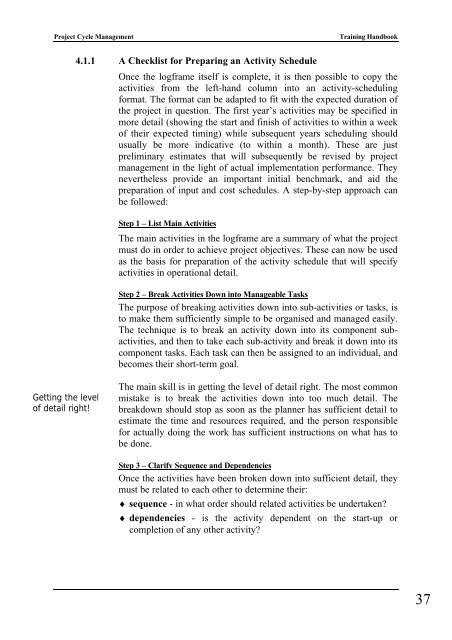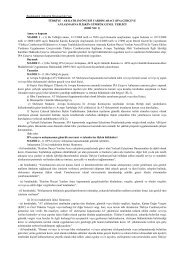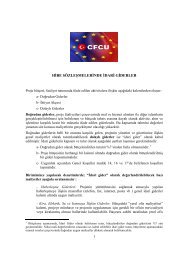Project Cycle Management Training Handbook - CFCU
Project Cycle Management Training Handbook - CFCU
Project Cycle Management Training Handbook - CFCU
Create successful ePaper yourself
Turn your PDF publications into a flip-book with our unique Google optimized e-Paper software.
<strong>Project</strong> <strong>Cycle</strong> <strong>Management</strong> <strong>Training</strong> <strong>Handbook</strong><br />
Getting the level<br />
of detail right!<br />
4.1.1 A Checklist for Preparing an Activity Schedule<br />
Once the logframe itself is complete, it is then possible to copy the<br />
activities from the left-hand column into an activity-scheduling<br />
format. The format can be adapted to fit with the expected duration of<br />
the project in question. The first year’s activities may be specified in<br />
more detail (showing the start and finish of activities to within a week<br />
of their expected timing) while subsequent years scheduling should<br />
usually be more indicative (to within a month). These are just<br />
preliminary estimates that will subsequently be revised by project<br />
management in the light of actual implementation performance. They<br />
nevertheless provide an important initial benchmark, and aid the<br />
preparation of input and cost schedules. A step-by-step approach can<br />
be followed:<br />
Step 1 – List Main Activities<br />
The main activities in the logframe are a summary of what the project<br />
must do in order to achieve project objectives. These can now be used<br />
as the basis for preparation of the activity schedule that will specify<br />
activities in operational detail.<br />
Step 2 – Break Activities Down into Manageable Tasks<br />
The purpose of breaking activities down into sub-activities or tasks, is<br />
to make them sufficiently simple to be organised and managed easily.<br />
The technique is to break an activity down into its component subactivities,<br />
and then to take each sub-activity and break it down into its<br />
component tasks. Each task can then be assigned to an individual, and<br />
becomes their short-term goal.<br />
The main skill is in getting the level of detail right. The most common<br />
mistake is to break the activities down into too much detail. The<br />
breakdown should stop as soon as the planner has sufficient detail to<br />
estimate the time and resources required, and the person responsible<br />
for actually doing the work has sufficient instructions on what has to<br />
be done.<br />
Step 3 – Clarify Sequence and Dependencies<br />
Once the activities have been broken down into sufficient detail, they<br />
must be related to each other to determine their:<br />
♦ sequence - in what order should related activities be undertaken?<br />
♦ dependencies - is the activity dependent on the start-up or<br />
completion of any other activity?<br />
37





